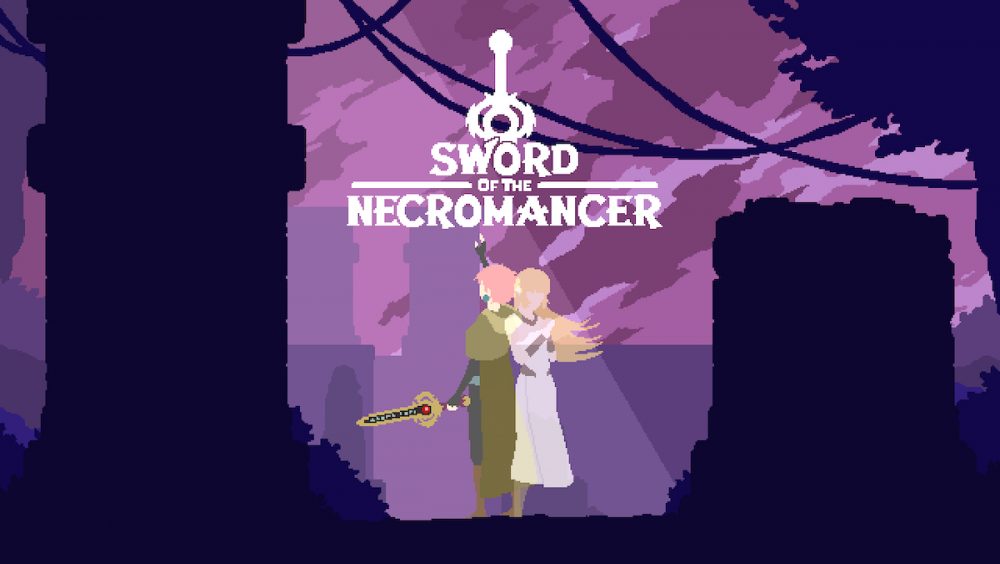Coming up with ideas on how to stand out in the crowded pixel-art indie-roguelike genre is an unenviable task. To Sword of the Necromancer’s credit, both its standard weapon-based combat and monster-revive mechanic are satisfying in action and feel well-balanced. However, despite possessing a strong narrative component expanded upon after you defeat each boss, there’s also a harsh progression system that ensures the story beats are stretched further and further apart the harder it gets, and repetition sets in.
Sword of the Necromancer puts you in the boots of the brigand-turned-bodyguard Tama, who has arrived in an ancient dungeon that was home to an ancient necromancer who overcame death. Tama’s charge, Koko, a young priestess looking to experience and understand the world before she ascends to power, has fallen. For reasons the player will only understand later, Tama is desperate to revive her, no matter the cost.

It’s a great setup, introduced by way of an impressive animated cutscene, for a typical roguelike dungeon-crawl that’ll see you clearing level after level, hunting for keys, equipment chests, and slaying bosses. Sword of the Necromancer has competent weapon-based combat, with different gear providing different attack ranges, area of affect sweeps, and combo potential (think swords, halberds, and bows). However, the novel feature is the ability to slay your foes with the titular “Sword of the Necromancer” and revive them as summonable companions.
After clearing a room of monsters, you can stand over any corpse and revive it using the Sword of the Necromancer. To summon a creature, you assign them to one of three available inventory slots – the fourth is always the sword – each assigned to a key or one of the face buttons if you’re using a gamepad (which I’d recommend). As you only have three slots to work with – slots also required for other weapon types and amulets/rings – you’ll need to decide if you’re prioritising weapon- or summons-based combat.

Summoned monster combat in [i]Sword of the Necromancer[/i] is mostly hands-off but follows a simple rock-paper-scissors formula. Slimes provide slow-moving ranged attacks that are effective en masse. Mage-like summons cast elemental orbs that can inflict damage through defences. Monsters with shields are great at tanking damage from lesser creatures and bosses. Even the weakest creatures – including a weird head-spider thing and flute-playing cherub – can ensnare enemies or buff your own units.
Monsters, once summoned, tend to roam in a small area, automatically engaging enemies, so you need to keep an eye on them and bring them along with you. As you progress, your summons can level-up basic skills, making them even more useful. To ensure their survival, you need to match the right summon against the right monster type. That said, dropping a diverse group comprising of a defensive, ranged, and magic-wielding summon typically works well regardless of the situation.

Unfortunately, Sword of the Necromancer’s gameplay loop clashes with its strong narrative elements. Defeating a boss grants you a lengthy, fully-voiced scene not dissimilar from a visual novel, which fleshes out the growing relationship between Tama and Koko. The problem is the harsh roguelike progression system that’ll strip you of any acquired gear, revived monsters, and half your player level (which provides boosts to your health, resistances, number of dashes etc.) any time you die (or need to quit out) and send you back to the first level of the dungeon.
On more than one occasion, poor back-to-back runs would ruin an hour of cautious progress, dragging out the interval between story beats as I attempted to tackle the same floors and bosses again and again. When you couple those setbacks with limited environment variation and having to deal with the same enemy selection (there’s only a small degree of randomisation to the levels and gear within them), repetition sets in and the disconnect between the gameplay and narrative becomes stark.

Overall, what Sword of the Necromancer may lack when it comes to a unique visual design or level structure, it makes up for with the narrative hook and monster-summoning gameplay options. Whether you’re hacking your way through hordes using weapons or a carefully selected menagerie of monsters, combat feels good and you’re only ever one boss away from another story beat. However, I found the harsh penalty for dying was completely at odds with the story, and I slowly grew tired of repeating earlier dungeons with no retained character or ability progress.
Sword of the Necromancer will be available on PlayStation 5, Nintendo Switch, Xbox Series X and Series S, PlayStation 4, Xbox One, and PC early 2021.
Did you enjoy reading our preview of a game before the game gets its final release and its final version? if yes, click here to find more early previews.








You must be logged in to post a comment.